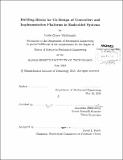| dc.contributor.advisor | Anuradha Annaswamy. | en_US |
| dc.contributor.author | Maldonado, Leslie Grace | en_US |
| dc.contributor.other | Massachusetts Institute of Technology. Department of Mechanical Engineering. | en_US |
| dc.date.accessioned | 2013-10-24T17:34:40Z | |
| dc.date.available | 2013-10-24T17:34:40Z | |
| dc.date.copyright | 2013 | en_US |
| dc.date.issued | 2013 | en_US |
| dc.identifier.uri | http://hdl.handle.net/1721.1/81609 | |
| dc.description | Thesis (S.M.)--Massachusetts Institute of Technology, Dept. of Mechanical Engineering, 2013. | en_US |
| dc.description | Cataloged from PDF version of thesis. | en_US |
| dc.description | Includes bibliographical references (p. 93-95). | en_US |
| dc.description.abstract | One of the biggest challenges in implementing feedback control applications on distributed embedded platforms is the realization of required control performance while utilizing minimal computational and communication resources. Determining such tradeoffs between control performance (e.g., stability, peak overshoot, etc.) and resource requirements is an active topic of research in the domain of cyber-physical systems (CPS). In this thesis, a setup is considered where multiple distributed controllers communicate using a hybrid (i.e., time- and event-triggered) communication protocol like FlexRay (which is commonly used in automotive architectures). Mapping all control messages to time-triggered slots results in deterministic timing and hence good control performance, but time-triggered slots are more expensive. The event-triggered slots, while being less expensive, result in variable message delays and hence poor control performance. In order to tradeoff between cost and control performance, a number of recent papers proposed a switching scheme where messages are switched between time- and event-triggered slots based on the state of the plant being controlled. However, all of these studies were based on a monotonic approximation of the system dynamics. This while simplifying the resource dimensioning problem (i.e., the minimum number of time-triggered slots required to realize a given control performance) leads to pessimistic results in terms of usage of time-triggered communication. In this thesis, it is shown that the usage of time-triggered communication (i.e., the requirement on the minimum number of time-triggered slots for a given control performance) is reduced when an accurate, non-monotonic behavior of the system dynamics is considered in the analysis. This technique is illustrated using a number examples and a real-life case study. While the focus is on communication resources in this thesis, these results are general enough to be applied to a wide range of problems from the CPS domain. | en_US |
| dc.description.statementofresponsibility | by Leslie Grace Maldonado. | en_US |
| dc.format.extent | 95 p. | en_US |
| dc.language.iso | eng | en_US |
| dc.publisher | Massachusetts Institute of Technology | en_US |
| dc.rights | M.I.T. theses are protected by
copyright. They may be viewed from this source for any purpose, but
reproduction or distribution in any format is prohibited without written
permission. See provided URL for inquiries about permission. | en_US |
| dc.rights.uri | http://dspace.mit.edu/handle/1721.1/7582 | en_US |
| dc.subject | Mechanical Engineering. | en_US |
| dc.title | Building blocks for co-design of controllers and implementation platforms in embedded systems | en_US |
| dc.type | Thesis | en_US |
| dc.description.degree | S.M. | en_US |
| dc.contributor.department | Massachusetts Institute of Technology. Department of Mechanical Engineering | |
| dc.identifier.oclc | 858871740 | en_US |
